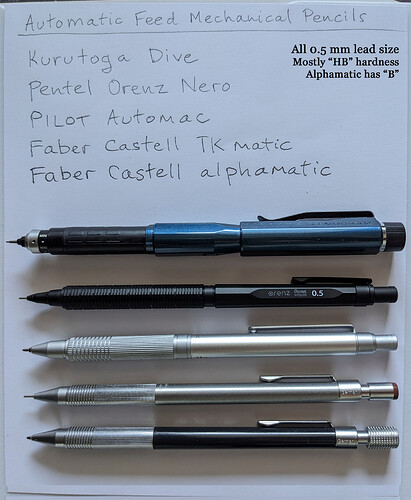I’ve used these 0.5 mm automatic feeding pencils, together (sequentially) in one session:
Uni Kuru Toga Dive
Pentel Orenz Nero
PILOT Automac
Faber Castell TK-matic
Faber Castell alphamatic
Criteria: Tip smoothness across paper, tip solidity, ease of auto feed, and overall feel
I rank them as follows:
- Faber Castell Alphamatic
- PILOT Automac
- Faber Castell TK-matic L
- Uni Kuru Toga Dive
- Pentel Orenz Nero
I am biased, because I’ve not experienced every automatic pencil available. I’m sadly unable to have a Pentel QX-PN305 on hand, reputedly the greatest automatic pencil of all time. I’ve also not been able to use a PILOT H-5005 or a Pentel PN3015 Technomatic. But these 5 on display above are among the top regarded automatic mechanical pencils you can buy today (or find used on the auction marketplaces).
I’m also not of mind to mandate a pipe guide or clutch forward design. The latter lends itself more to general writing vs. drafting. But technically, all of these pencils do just fine with normal writing. They’re all great writing instruments.
BEST: The Faber Castell alphamatic is a legend. It was also a pencil I sought after for a long time, not wanting to pay over going market rates to get a fine condition one. I eventually got one for a decent price. And it has fully lived up to my expectations. It is the right idea for simplicity. Without a pipe guide, you end up with the rounded tip of a well angled clutch shield that provides good glide on the paper. And the auto-feed functions with hardly any detection. The lead is there and it keeps coming.
2ND: I put the PILOT Automac a close second. The tip set-up feels very similar to the alphamatic. I cannot articulate exactly why it’s not #1. But it’s close. At least my example (some have reported annoying tip wobble–my two examples don’t suffer it).
3RD: The Faber Castell TK-matic L is another legend. This one uses a pipe guide. FC was smart about avoiding a chisel edge on the guide rim, with just a touch of chamfering. The tip isn’t quite as smooth as the alphamatic, but then it sports the pipe guide for more versatility. It can do drafting work, while the alphamatic isn’t suited for it.
4TH Why is the fabled Kuru Toga Dive at #4? It’s a terrific pencil in so many respects. And while I do not get a tip “wobble” effect (side to side) there is a slight vertical movement. In my book, the ideal is a firm lead with no easily detectable movement when lead touches paper. But, once you get used to that quality? Well, this is a remarkable pencil with a supreme mechanism unlike any other. You do not need for the pipe guide to drag on paper to trigger the lead auto-feed. My only gripe is that Uni Ball Co opted for an all plastic body. It just feels a bit cheap on first impression. Clearly the mechanism is the big value here. I really wish a little more substantial material was used. But the automatic lead advancement upon uncapping is a nifty feature. Magnetic closure of capping and posting is terrific. If sold at $40 USD, it’s a great value. Sadly, there was a horrible pricing fiasco due to Uni Ball Co failing to adequately deal with scalpers. It’s still $98 brand new, and occasionally on discount (down to $60 USD). I bought mine from Yoseka Stationery during the dry periods, for $72 shipped. Still overpriced… but I’m glad I have it.
5TH: The Pentel Orenz Nero. It’s the best value here, with available pricing as it is today. Once teased at first in a limited edition color commanding upwards of $100, you can now buy these on sale for about $15 USD. Even cheaper when lightly used (although shipping kills the price advantage). Like the TK-matic, it requires the pipe guide to contact paper to trigger the auto-feed. But somehow, it’s not as smooth. I find myself periodically coaxing the lead out manually. And then why bother with automatic? I expect with a softer lead it’ll be smoother.
FINAL COMMENT:
Overall, this is more of a curiosity for me. I’m not a big fan of automatic lead feed. I don’t think it’s really necessary. This isn’t like cars with automatic shift vs. manual shift. The effort to advance lead isn’t hard. The only time I’d say it’s great is when writing long periods in free hand. The Kuru Toga engine is ideal for that. That’s where automatic feed shines. But otherwise? It’s more of a gimmick. In my nearly 12 years of collecting and using nice quality mechanical pencils, my epiphany came in the form of a body-knock. It’s not the most elegant form of lead advancement. The thought of the pencil bending a little at the middle seems… almost comical. Embarrassing even. But, it does happen in a split second. A brief “vulnerability” to do the business. And that quick easy squeeze of the hand to make it happen means your fingers don’t move. Your pencil orientation remains the same. No winding the thumb up to the top end of the pencil to push. No “shake” up and down. No index finger manipulating a side button or lever. Arguably, one could say the FF-matic “finger flick” is better. It’s great… but not at the price commanded.
For body-knock, the champion in my book is KOKUYO. rOtring is great too. The 900 and their “side knock” (a Mistral redress) are tops. And nobody has a telescoping body-knock like the Artline Shachihata.
